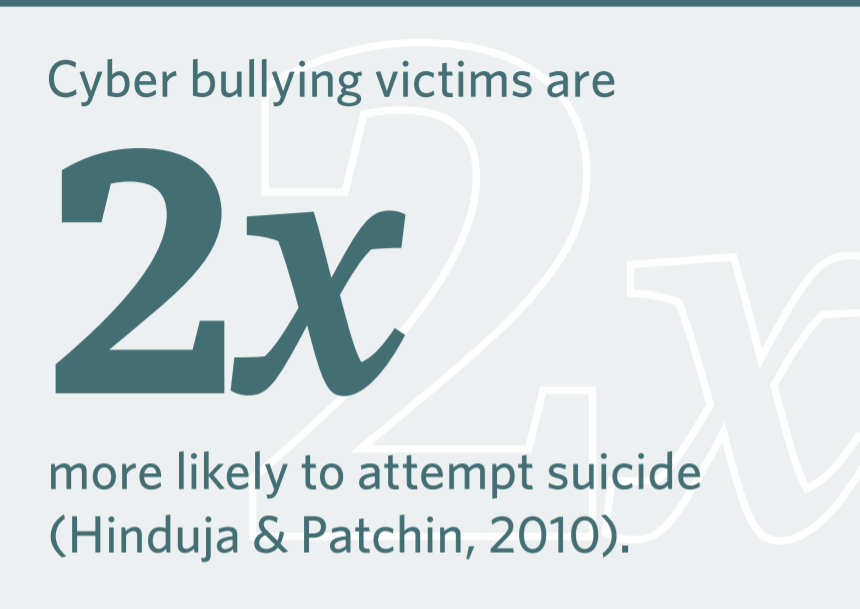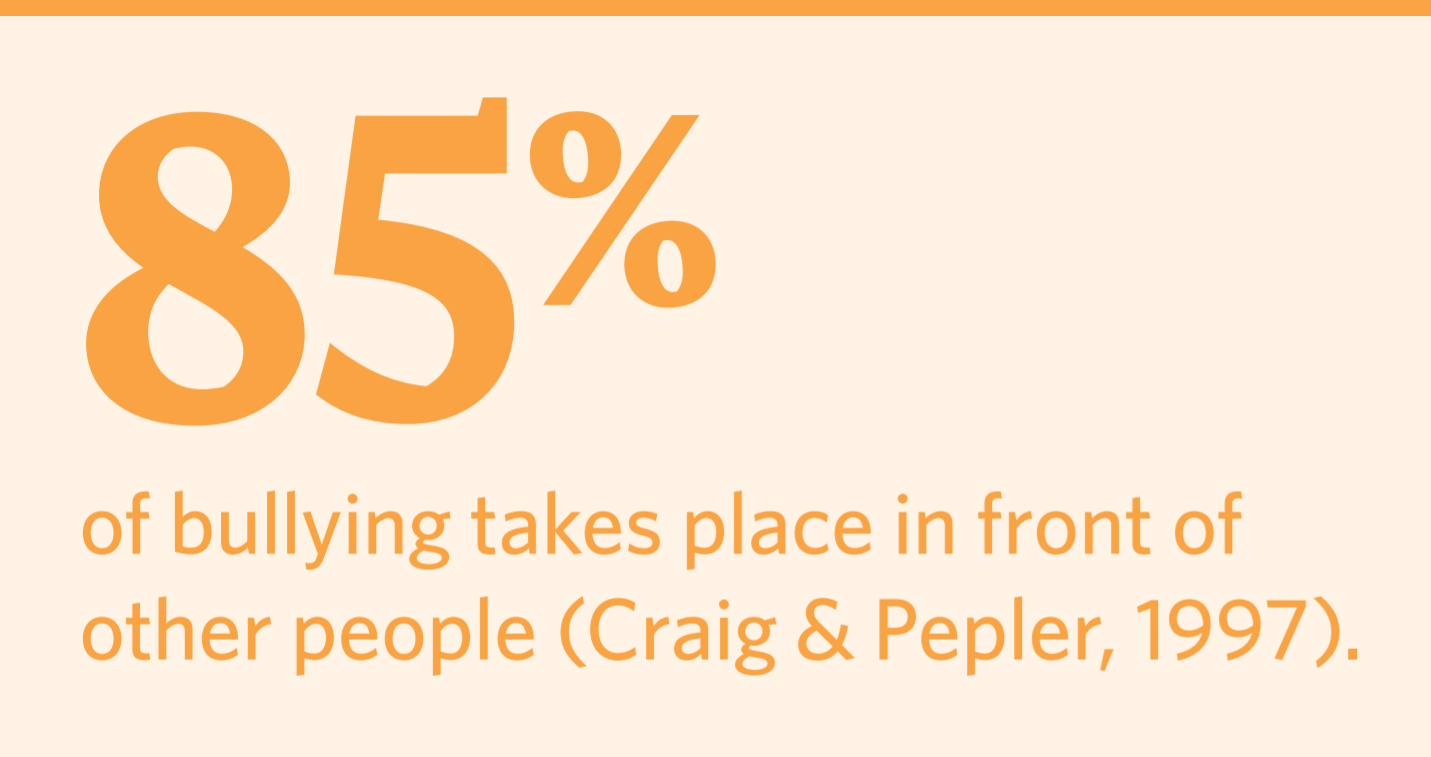How might the target feel when they are being bullied?
sad, lonely, embarrassed, angry, confused, isolated, like they want to hurt themselves, like they want to escape from their body and mind, like they want to hurt someone else (remember Naomi and Callie's sister and her message: hurt people hurt people and healed people heal people)
What percentage of Canadian youth aged 12-17 experience bullying?
According to the 2019 Canadian Health Survey on Children and Youth ( CHSCY ), the majority of Canadian youth aged 12 to 17 (71%) reported experiencing at least one form of bullying in the past twelve months.
You see a girl being teased at recess.
Tell an adult. Provide support and empathy. Remove the girl from the teasing.
There are negative consequences for both sides. What are the effects of bullying others?
- Depression: Resulting from guilt or internal conflict.
- Substance Abuse: Using drugs or alcohol as coping mechanisms.
- Aggression: Reinforced aggressive tendencies and antisocial behaviours.
- Sexual Harassment: Potential for aggression in relationships.
- Academic Struggles: Distractions leading to poor performance and increased dropout rates.
- Criminal Behaviour: Progression to delinquent actions.
If you are bullied, it is best to handle it alone?
False
There can be more power and influence in numbers.
What are some different types of bullying?
VERBAL BULLYING
- sarcasm;
- threats;
- negative, insulting, humiliating comments; or
- unwanted sexual comments.
SOCIAL BULLYING
- spreading rumours or damaging someone’s reputation;
- excluding others from a group;
- humiliating others with public gestures or graffiti; or
- damaging someone’s friendships.
PHYSICAL BULLYING
- intentional physical aggression towards another person;
- destroying or stealing belongings; or
- unwanted sexual touching.
CYBER BULLYING

- Using electronic communication (e.g., internet, social media or text messaging) to:
- intimidate;
- put-down;
- spread rumours;
- make fun of someone; or
- disseminate private or embarrassing information or images of a person without their permission (Alberta Human Services, 2015).
What percentage of bullied youth face it monthly?
42% of bullied youth face it monthly, 58% sporadically.
Your best friend has recently started to pick on another student in the class. At first, you thought it was funny, but lately, the teasing has gotten meaner and meaner. You can tell that the student is becoming more and more upset, but the other kids in the class think it is funny.
Tell a teacher. Talk to your best friend about his/her behavior. Support the target.
What are the impacts of being bullied?
- Mental Health: Depression, anxiety, and mood disorders.
- Substance Abuse: Use of drugs or alcohol to cope.
- Low Self-Esteem: Erosion of self-confidence.
- Isolation: Withdrawal from social situations.
- Physical Symptoms: Manifestations like stomach aches, headaches.
- Educational Issues: Decreased attendance and learning difficulties.
- Suicidal Tendencies: Emotional pain leading to suicidal thoughts or actions
People who bully others have trouble making friends?
False
Some people might have trouble but not all.
What can we do as a class to prevent bullying?
Get the whole class and school on board to learn about nonviolent communication. Teach children and youth HOW to love THEMSELVES. Build up our own self-esteem, self-compassion, and self-love that will allow us to love and respect others. Let others know that they are not alone and that they have a community of support. Support the people doing the bullying because it's likely they have experienced bullying in the past (by a parent, caregiver, older sibling, other). They might come from dysfunctional homes and might be mimicking behaviours they have witnessed in the home. They might also be a victim of child abuse themselves. This in no way excuses their behaviour; however, it offers us understanding and compassion for them as well.

Elementary students face bullying every ____ minutes.
- Elementary students face bullying every 7 minutes.
- 85% of these incidents have bystanders.
- With bystander intervention, 57% of bullying stops in ten seconds.
What is a positive way to handle a person who is bullying others?
Tell an adult. Stand up for yourself in a positive way. Get help from peers and friends. There is power in numbers.
- Social Isolation: Individuals, especially children and youth, who have fewer friends or are perceived as isolated are often targeted by bullies. This group’s perceived inability to defend themselves or lack of social support makes them attractive targets for bullies.
- Physical or Developmental Differences:
- Those with disabilities or neurodevelopmental differences can be targeted due to perceived vulnerabilities or lack of understanding from their peers.
- Children with special healthcare needs or intellectual exceptionalities, whether gifted or with learning disabilities, may face bullying due to their unique needs or skills that set them apart from their peers.
- Body Image Issues: Overweight children and youth may be more prone to bullying due to societal biases, stereotypes, or prejudices against their body type.
- LGBTQ Identification: Canadian children and youth who identify as LGBTQ often face increased risks of bullying. This stems from societal biases, misunderstandings, or prejudices against non-heteronormative orientations or identities.
Sometimes bystanders are afraid to report the bullying? Why?
True Why?
Fear of retaliation and being bullied themselves.
Fear of losing their social status.
They are not friends with the target of the bullying.
Lack of knowledge about the individuals involved, the incident, and whether they perceive someone to be right or wrong in the situation.
They do not believe teachers or school staff will address the bullying.
They believe that adults will make the bullying worse.
They do not know what to do to intervene or address bullying.
What can a bystander do?
Prevention and Intervention
Bystanders can take positive actions to prevent bullying and to address it while it is happening or after it occurs. Parents, teachers, and other caring adults can recommend safe ways that bystanders can prevent, intervene, or address bullying.
Prevention steps include:
- Being inclusive by welcoming others to join their activities and groupsSalmivalli, C., (2014) "Participant Roles in Bullying: How Can Peer Bystanders Be Utilized in Interventions?," Theory Into Practice, 53:4, 286‐292, DOI: 10.1080/00405841.2014.947222. To link to this article: https://doi.org/10.1080/00405841.2014.947222
- Being a role model for pro-social behavior by showing kindness, respect, and empathy for others.
- Walking or sitting with or near vulnerable kids who may be targets of bullying.
- Getting involved with bullying prevention efforts at school or in the community
Bystander interventions during a bullying incident may include:
- Defending the target of the bullying
- Intervening as a groupSalmivalli, C., (2014) "Participant Roles in Bullying: How Can Peer Bystanders Be Utilized in Interventions?," Theory Into Practice, 53:4, 286‐292, DOI: 10.1080/00405841.2014.947222. To link to this article: https://doi.org/10.1080/00405841.2014.947222
- Changing the subject
- Questioning the bullying behavior
- Using humor to lighten up a serious situation
- Openly stating an objection to bullying
- Stating approval of the victim and validating his or her social status
Bystanders can address bullying after it happens by:
- Reaching out privately to the target of the bullying to express support or concern.
- Reporting the bullying to a trusted adult, parent, teacher, or school administrator.
- Reaching out privately to the person doing the bullying to express concern, if they feels safe to do so
What percentage of Canadians are bullied in the workplace every week?
40% or nearly half of Canadians are bullied in the workplace every week.
A group of your friends are talking negatively about another boy in your class. You think this boy is nice and consider him to be a friend.
Ask them to stop. Continue to be friends with the boy.
Who is at risk of bullying others?
- Normalization of Aggression: Children and youth who grow up in environments or cultural contexts where bullying or aggressive behaviour is normalized may come to view such behavior as acceptable and may become bullies themselves.
- Peer Influence: Those who have friends that bully or belong to peer groups where bullying is common might adopt similar behaviours to fit in or exert dominance within their group.
- Diverse Social Backgrounds: Bullying is not restricted to one social group. While some bullies might be popular and socially skilled, using bullying as a tool to maintain their social status, others may have behavioural problems, feel socially isolated, and use bullying as a way to exert control or express their frustrations.
It takes courage to report bullying to an adult?
True
Define empathy. How do we build empathy in others?
The ability to understand how another person feels and why the person feels that way.
Developing empathy is a powerful antidote to bullying. Encourage students to understand and connect with others' feelings and experiences. Foster a culture of kindness and compassion. Empower individuals to stand up against bullying and create a more inclusive and caring community.What percentage of bullying takes place in front of other people?

One of your friends frequently spreads rumors about you, tells you that your clothes are ugly, and says she won't be your friend. You are confused by this behavior because you thought this girl was really your friend.
Tell your friend that her behavior is unkind. Ask your friend to stop. If she doesn't stop, you might need to think about not being friends with her anymore. Trust is important in all relationships.
What are ways that adults can support youth who are being bullied?
Educate About Bullying
- Discuss what bullying is and its unacceptability.
- Instruct kids on safe ways to stand up against bullying.
- Ensure children understand the importance of seeking help if they or someone else is bullied.
Maintain Open Communication
- Regularly check in with kids, discussing their day and any concerns they might have.
- Start direct conversations about bullying, understanding their perspective and feelings.
- Encourage honest responses and ensure they know they’re not alone in facing these issues.
Promote Positive Activities
- Encourage kids to engage in activities, hobbies, or interests they love.
- Such involvement can boost their confidence, help them make friends, and act as a protective factor against bullying.
Set a Positive Example
- Demonstrate kindness and respect in your interactions.
- Children learn from observing adults, so showcasing positive behaviour discourages bullying tendencies.
Stay Informed and Involved
- Keep up with school communications, attend school events, and interact with school staff.
- Having a presence and understanding of the school environment can be a deterrent to bullying.
Frequent bullying can have a long-term affect on the target? How?
True How?
Bullying is related to negative psychological, emotional and behavioural outcomes. These outcomes can eventually make youth feel as though they can no longer cope (Wade & Beran, 2011).
Bullying is linked to several precursors to thoughts of suicide (Hinduja & Patchin, 2010):
- depression and hopelessness;
- low self-esteem;
- loneliness and isolation;
- anger and frustration;
- humiliation;
- embarrassment; or
- trauma.
When bullying is accompanied by other risk factors, it often causes suicidal ideation (Hinduja & Patchin, 2010; Olson, 2012; Holt et al., 2015). Risk factors for suicidal ideation include:
- bullying;
- sexual abuse;
- physical abuse;
- drug abuse; or
- depression.
Both bullying victims and those who perpetuate bullying are at a higher risk for suicide. Kids who are involved as both victims and perpetrators of bullying are at the highest risk for suicide (Holt et al, 2015,